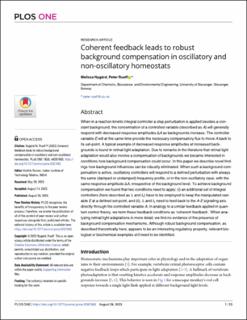| dc.contributor.author | Nygård, Melissa | |
| dc.contributor.author | Ruoff, Peter | |
| dc.date.accessioned | 2023-10-19T13:40:09Z | |
| dc.date.available | 2023-10-19T13:40:09Z | |
| dc.date.created | 2023-08-29T08:42:07Z | |
| dc.date.issued | 2023-08 | |
| dc.identifier.citation | Nygård, M. & Ruoff, P. (2023) Coherent feedback leads to robust background compensation in oscillatory and non-oscillatory homeostats. PLoS One | en_US |
| dc.identifier.issn | 1932-6203 | |
| dc.identifier.uri | https://hdl.handle.net/11250/3097616 | |
| dc.description.abstract | When in a reaction kinetic integral controller a step perturbation is applied besides a constant background, the concentration of a controlled variable (described as A) will generally respond with decreased response amplitudes ΔA as backgrounds increase. The controller variable E will at the same time provide the necessary compensatory flux to move A back to its set-point. A typical example of decreased response amplitudes at increased backgrounds is found in retinal light adaptation. Due to remarks in the literature that retinal light adaptation would also involve a compensation of backgrounds we became interested in conditions how background compensation could occur. In this paper we describe novel findings how background influences can be robustly eliminated. When such a background compensation is active, oscillatory controllers will respond to a defined perturbation with always the same (damped or undamped) frequency profile, or in the non-oscillatory case, with the same response amplitude ΔA, irrespective of the background level. To achieve background compensation we found that two conditions need to apply: (i) an additional set of integral controllers (here described as I1 and I2) have to be employed to keep the manipulated variable E at a defined set-point, and (ii), I1 and I2 need to feed back to the A-E signaling axis directly through the controlled variable A. In analogy to a similar feedback applied in quantum control theory, we term these feedback conditions as ‘coherent feedback’. When analyzing retinal light adaptations in more detail, we find no evidence of the presence of background compensation mechanisms. Although robust background compensation, as described theoretically here, appears to be an interesting regulatory property, relevant biological or biochemical examples still need to be identified. | en_US |
| dc.language.iso | eng | en_US |
| dc.publisher | Public Library of Science (PLoS) | en_US |
| dc.rights | Navngivelse 4.0 Internasjonal | * |
| dc.rights.uri | http://creativecommons.org/licenses/by/4.0/deed.no | * |
| dc.title | Coherent feedback leads to robust background compensation in oscillatory and non-oscillatory homeostats | en_US |
| dc.type | Peer reviewed | en_US |
| dc.type | Journal article | en_US |
| dc.description.version | publishedVersion | en_US |
| dc.rights.holder | © 2023 Nygård, Ruoff | en_US |
| dc.source.volume | 18 | en_US |
| dc.source.journal | PLOS ONE | en_US |
| dc.source.issue | 8 | en_US |
| dc.identifier.doi | 10.1371/journal.pone.0287083 | |
| dc.identifier.cristin | 2170415 | |
| cristin.ispublished | true | |
| cristin.fulltext | original | |
| cristin.qualitycode | 1 | |

